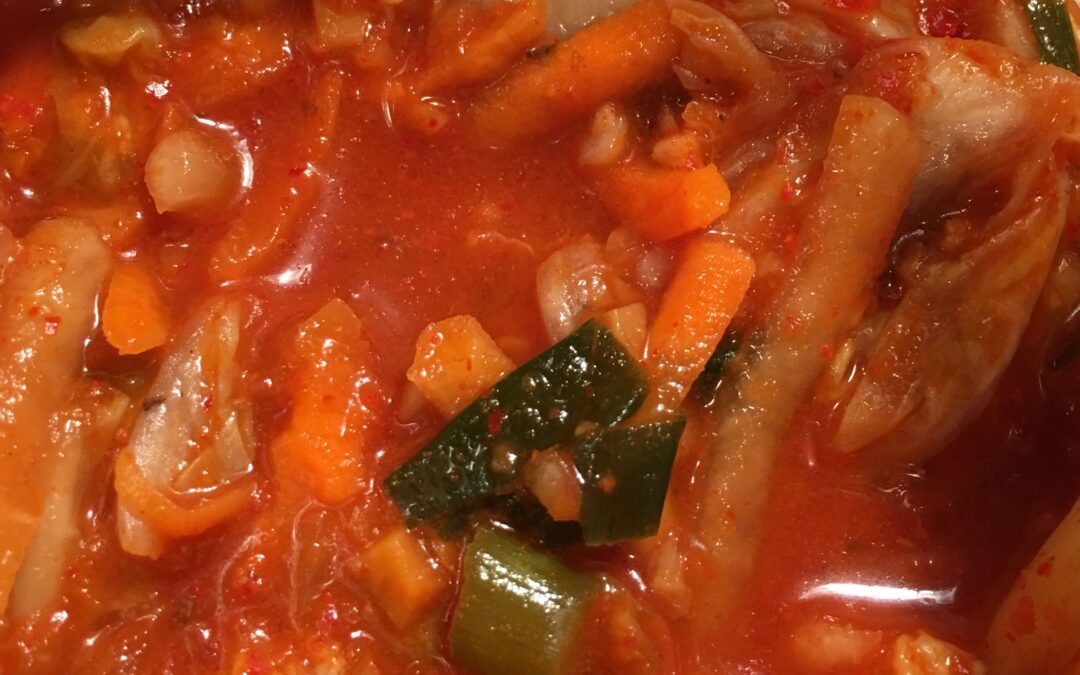Kimchi
Yield: about 4 pints
Brine ingredients
- 1 large napa cabbage
- 1/2 cup coarse salt (Not to worry; the salt will be washed off after brineing)
“Fish” sauce slurry ingredients
- 3/4 cup hot water
- 1 dried shiitake mushroom
- A chunk of dried seaweed about the size of your palm OR 1 sheet nori
- 1-2 teaspoons salt
- 2 teaspoons glutinous rice flour
- 1 tbsp chickpea miso OR coconut aminos
Other ingredients
- 1 jalapeño, — optional
- 1 daikon radish
- 3 carrots
- 6-9 scallions — optional
- 7-8 garlic cloves
- 1 small sweet OR red onion
- 1″ slice ginger, peeled
- 2-4 tbsp gochugaru aka Korean red pepper flakes/powder — see note
METHOD
Salting the napa cabbage
- Trim stalk end of cabbage & remove loose or discolored leaves
- Quarter the cabbage, then half the quarters, then slice into generous bite-sized chunks
- Rinse and drain the chopped cabbage (I use a salad spinner)
- In a very large bowl place a layer of chopped cabbage, sprinkle on some of the salt and repeat layering until all the cabbage is salted
- Cover tightly with plastic wrap and set aside at room temperature away from direct sunlight for four (4) hours. Cabbage will shrink to about half its original volume
- After four hours, drain the brine that has formed and rinse the cabbage well to remove the salt
‘Fish’ slurry
- While the cabbage is brineing, tear the seaweed into small pieces
- In a microwave safe bowl combine the hot water, shiitake mushroom and seaweed; set aside to rehydrate
Prepare the vegetables
- Peel and coarsely shred the carrot and daikon
- Slice the scallions
- Cut the jalapeño
- Chop the onion
- Finely mince the garlic and ginger
Creating the “fish” sauce slurry
- Remove the seaweed and rehydrated mushroom from the soaking water, RESERVE THE SOAKING WATER; finely mince the mushroom and add it to the prepared vegetables
- Add rice flour to the soaking water and whisk until no lumps remain. Microwave for 3 minutes, stirring every 30 seconds; OR bring the mixture to a boil on the stove and let it cool. The resulting liquid should be thick and gravy-like
- Stir in the salt and chickpea miso
Assembling the kimchi
- Using gloves to protect your hands, combine all ingredients and toss gently to coat.
- Fill wide mouth pint or quart mason jars about 3/4 full (to allow for expansion), pressing down to release any air pockets
- Cover the jars and let ferment at room temperature in a dark place. As fermentation occurs, gases will develop, so make sure the lid is loose enough to let this escape or use fermenting lids. Over time, more water will leech from the vegetables making the kimchi look liquidy. Check the kimchi after 24 – 36 hours. When the kimchi is ready there will be more liquid in the jars that bubble up when the jars are moved
- When your kimchi is ready, you can use it right away or store in the fridge. Cold fridge temp will slow the fermentation process but not halt it. Over time, the kimchi will get more and more acidic. Since fermentation is still going on in the fridge, crack open the jars periodically to release naturally occurring fermentation gasses
Recipe notes
- Use 2 tbsp gochugaru for medium spiciness; use 4 tbsp for hot. For extra heat add up to 1 tsp additional gochugaro to each jar. This allows various levels of heat in one batch of kimchi
- The fermentation stage of this recipe can take anywhere from one to four days, depending on room temperature

